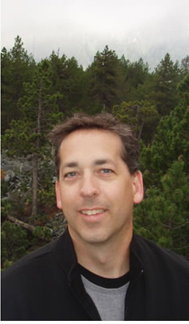We’re very pleased to welcome Greg Lowry and Jim Hutchison as the Associate Editors for Environmental Science: Nano – the unique RSC journal dedicated to nanomaterial interactions with biological and environmental systems:
 Dr Gregory Lowry is a Professor in the Department of Civil and Environmental Engineering at Carnegie Mellon University. Prior to this, he carried out his PhD and post-doctoral research at Stanford University until 2001. His research interests include mineral-organic macromolecule-water interfacial processes, and transport and reaction in porous media, with a focus on the fundamental physical/geochemical processes affecting the fate of engineered nanomaterials and organic contaminants in the environment. He is also investigating the processes affecting the permanence of CO2 injected underground for carbon sequestration. He is an experimentalist working on a variety of fundamental and application-oriented research projects developing novel environmental technologies for restoring contaminated sediments and groundwater. His current projects include in situ sediment management using innovative sediment caps and DNAPL source zone remediation through delivery of reactive nanoparticles to the NAPL-water interface. He is currently the Deputy Director of the Center for Environmental Implications of NanoTechnology (CEINT).
Dr Gregory Lowry is a Professor in the Department of Civil and Environmental Engineering at Carnegie Mellon University. Prior to this, he carried out his PhD and post-doctoral research at Stanford University until 2001. His research interests include mineral-organic macromolecule-water interfacial processes, and transport and reaction in porous media, with a focus on the fundamental physical/geochemical processes affecting the fate of engineered nanomaterials and organic contaminants in the environment. He is also investigating the processes affecting the permanence of CO2 injected underground for carbon sequestration. He is an experimentalist working on a variety of fundamental and application-oriented research projects developing novel environmental technologies for restoring contaminated sediments and groundwater. His current projects include in situ sediment management using innovative sediment caps and DNAPL source zone remediation through delivery of reactive nanoparticles to the NAPL-water interface. He is currently the Deputy Director of the Center for Environmental Implications of NanoTechnology (CEINT).
 Dr. James E. (Jim) Hutchison earned his B.S. in chemistry from the University of Oregon and his Ph.D. in organic chemistry from Stanford University. He conducted postdoctoral research at the University of North Carolina. He joined the faculty at the University of Oregon in 1994 where he is currently the Lokey-Harrington Chair in Chemistry. His research interests are in green chemistry, materials chemistry and nanoscience. He led the development of the UO’s curriculum in green organic chemistry, launched the university’s pioneering Center in Green Nanoscience and is a member of the Governing Board of the ACS Green Chemistry Institute. He helped establish the Oregon Nanoscience and Microtechnologies Institute (ONAMI) and founded, and now directs, ONAMI’s Safer Nanomaterials and Nanomanufacturing Initiative (SNNI), a virtual center that unites scientists from across the northwest around the goals of designing greener nanomaterials and nanomanufacturing. He is a member of the National Research Council’s Committee to Develop a Research Strategy for Environmental, Health, and Safety Aspects of Engineered Nanomaterials. He has won a number of awards, including the Alfred P. Sloan Research Fellowship and an NSF-CAREER award. He is the author of more than 100 refereed publications and a textbook (“Green Organic Chemistry: Strategies, Tools and Laboratory Experiments”).
Dr. James E. (Jim) Hutchison earned his B.S. in chemistry from the University of Oregon and his Ph.D. in organic chemistry from Stanford University. He conducted postdoctoral research at the University of North Carolina. He joined the faculty at the University of Oregon in 1994 where he is currently the Lokey-Harrington Chair in Chemistry. His research interests are in green chemistry, materials chemistry and nanoscience. He led the development of the UO’s curriculum in green organic chemistry, launched the university’s pioneering Center in Green Nanoscience and is a member of the Governing Board of the ACS Green Chemistry Institute. He helped establish the Oregon Nanoscience and Microtechnologies Institute (ONAMI) and founded, and now directs, ONAMI’s Safer Nanomaterials and Nanomanufacturing Initiative (SNNI), a virtual center that unites scientists from across the northwest around the goals of designing greener nanomaterials and nanomanufacturing. He is a member of the National Research Council’s Committee to Develop a Research Strategy for Environmental, Health, and Safety Aspects of Engineered Nanomaterials. He has won a number of awards, including the Alfred P. Sloan Research Fellowship and an NSF-CAREER award. He is the author of more than 100 refereed publications and a textbook (“Green Organic Chemistry: Strategies, Tools and Laboratory Experiments”).
To find out more about the scope of Environmental Science: Nano head to the dedicated webpage










